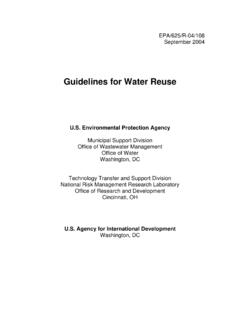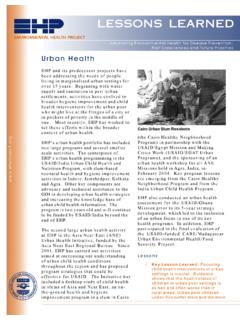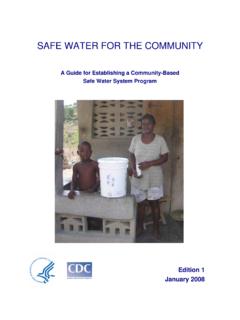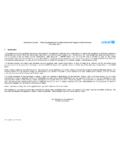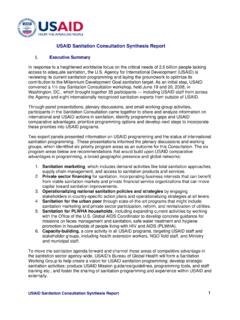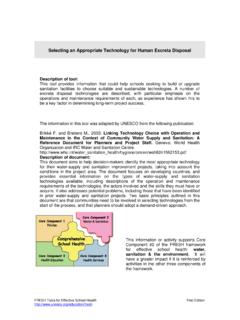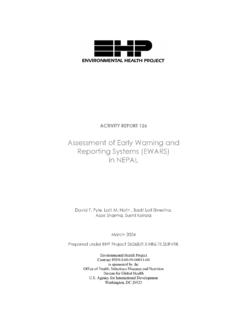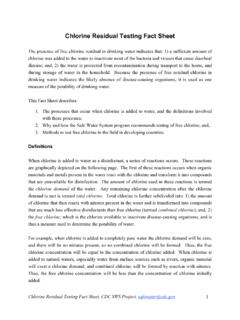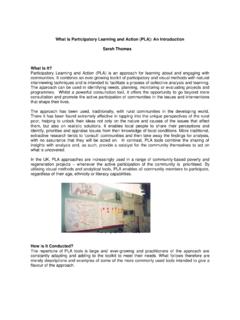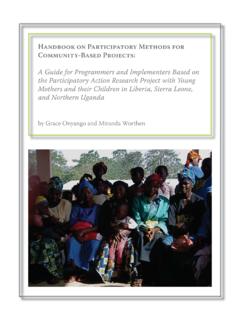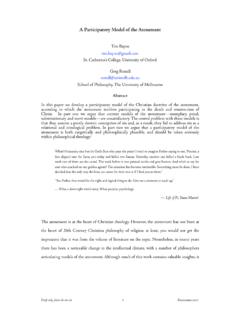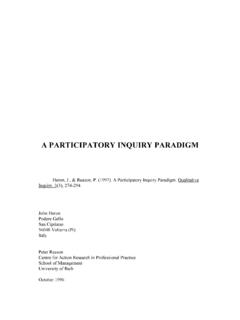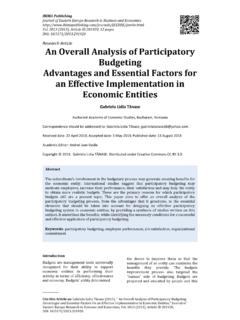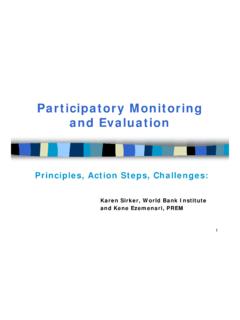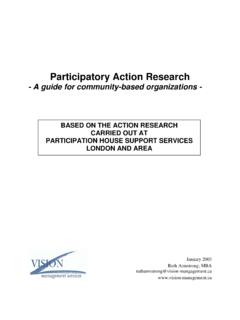Transcription of Participatory Community Monitoring for Water, …
1 Activity Report 141. Participatory Community Monitoring for water , Sanitation, and Hygiene The NicaSalud Experience Translated and Edited by Charlotte Storti October 2004. Prepared Under EHP Project 26568 Environmental Health Project Contract HRN-I-00-99-00011-00. is sponsored by the Office of Health, Infectious Diseases and Nutrition Bureau for Global Health Agency for International Development Washington, DC 20523. Content v About the Author .. vii Executive Summary .. ix 1. Why Use Participatory Community Monitoring ?.. 1. Participatory Monitoring .. 1. Sharing 2. Parameters and indicators for hygiene improvement programs .. 3. Gender issues .. 6. Community participation 6. Community 9. 2. Methodology Phases and 11. Human resources for integrating PCM into the organization and 11. The four phases of the PCM methodology .. 12. 3. Institutionalizing the 21. 23. 25. iii Abbreviations ANASAM Asociaci n Nicarag ense de Agua y Saneamiento Ambiental (Environmental water and Sanitation Association).
2 CAPS Comit de Agua Potable y Saneamiento (Drinking water and Sanitation Committee). EHP Environmental Health Project ENACAL Empresa Nicarag ense de Acueductos y Alcantarillados (Aqueducts and Sewers Company of Nicaragua). HIF Hygiene Improvement Framework INPRHU Instituto de Promotion Humana (Institute of Human Development). M&E Monitoring and evaluation NGO Nongovernmental organization NicaSalud Federacion Red NicaSalud (Nicaragua Health System Federation). PCI Project Concern International PCM Participatory Community Monitoring USAID United States Agency for International Development WSH water , sanitation, and hygiene v About the Author Charlotte Storti specializes in the writing and editing of health and health-related materials, including field guides, handbooks, training manuals, project reports and evaluations, and other technical documents. She was trained as a registered nurse and worked for many years as a public health professional in international and domestic health care programs.
3 As a health educator, program manager, and/or technical training advisor, she has worked with national governments, PVOs, and local NGOs. Her practice area is primary health care with a focus on maternal and child health. She is fluent in Spanish. vii Executive Summary This report summarizes the NicaSalud report, Experiencias en la implementaci n de la Metodolog a de Monitoreo Comunitario Participativo para Agua, Higiene y Saneamiento, (in Spanish) on the Participatory Community Monitoring methodology and its application by three nongovernmental organizations (NGOs) in Nicaragua. The original report, as prepared by members of the NicaSalud water , Sanitation, and Hygiene Working Group ANASAM, PCI, and IMPRHU documents the Participatory Community Monitoring (PCM) Initiative project that NicaSalud developed with funding and technical assistance from the United States Agency for International Development (USAID) through the Environmental Health Project (EHP).
4 This summary highlights the PCM methodology for use by program planners and managers who would like to include PCM in their water , sanitation, and hygiene programs. Participatory Community Monitoring for water , sanitation, and hygiene (WSH) makes it possible for: Communities to make their own decisions about water , hygiene, and sanitation strategies Communities to feel a sense of project ownership Development organizations to better understand local Community wishes and priorities Participatory Community Monitoring is a strategy for generating Community participation in management and decision-making in the Community . PCM. establishes a process whereby Community members share Monitoring responsibilities with development organizations, but it is not a tool for measuring project impact. The methodology is implemented in four phases and conducted in 24 steps. Two EHP reports contributed to the development of this methodology.
5 The first report1 researched the Participatory Monitoring and evaluation literature and concluded that EHP should develop a Participatory Monitoring methodology for use in WSH projects and relevant training materials for field staff. The second report, an analysis of the Monitoring experiences and methods of Nicaraguan NGOs working in WSH,2 concluded that: There is a lack of Participatory methods and tools in Monitoring activities. Community participation in the Monitoring process is very limited. Certain groups in the Community are excluded from Monitoring activities. 1. Judi Aubel, Participatory Monitoring & Evaluation for Hygiene Improvement Beyond the toolbox: What else is required for effective PM&E? A Literature Review, EHP, Arlington, Virginia, November 2004. 2. Marissa Azmitia, Analysis of Experiences, Materials and Tools Existing in Nine NGOs on Monitoring , EHP, Arlington, Virginia, July 2003. ix The indicators used only measure access to infrastructure and hygiene habits and do not include Community roles and capabilities in promoting health.
6 Community groups and leaders have the will and the interest to maintain WSH. projects after the NGOs have departed. Generally, the NGOs make all the decisions about the design of the Monitoring systems. How this report is organized This report is organized into three sections and an annex, as described below: 1. Why Use Participatory Community Monitoring ? This section explains why this methodology was created and identifies the key issues that NGOs need to address in designing a PCM program. 2. Methodology Phases and Steps. This section presents the four phases and 24 steps of the methodology. In Phase 1, the organization designs a PCM strategy. In Phase 2, the organization conducts an internal needs assessment and conducts training for its staff. In Phase 3, the organization introduces PCM to the Community and conducts training. In Phase 4, the organization and the Community conduct the PCM activities. 3. Institutionalizing the Methodology.
7 This section explains how organizations can integrate the PCM methodology into their Monitoring system and how communities can make PCM an ongoing tool for their development. Annex: Tools for Applying PCM-WSH. The annex identifies key Participatory methods and tools, highlights their advantages and disadvantages, and describes when and with whom they should be used. x 1. Why Use Participatory Community Monitoring ? Participatory Community Monitoring has many benefits, including: Encourages key members of a local project to participate, allowing them to reflect on their own experiences and learn from them Enables administrators, field staff, and Community members to better understand the project dynamics and thereby improves implementation Allows Community members to express their priorities and their criticism of project development strategies Increases the sense of ownership on the part of local development staff and Community members and provides recommendations for future action There are six key issues that need to be understood before implementing Participatory Community Monitoring in the context of water , hygiene, and sanitation projects.
8 These topics are described in detail below. They are: 1. The differences between traditional and Participatory Monitoring 2. The importance of sharing responsibilities between the development organization and the Community 3. Parameters and indicators for hygiene improvement programs 4. Gender issues 5. The levels of Community participation 6. The concept of Community empowerment Participatory Monitoring Chart 1 identifies the main differences between more traditional Monitoring and Participatory Monitoring in four key areas. 1. Chart 1. Traditional and Participatory Monitoring Areas Traditional Monitoring Participatory Monitoring 1. Purpose of Monitoring To measure progress relative to To measure successes the project plan. qualitatively as well as quantitatively. To develop lessons learned to be integrated into the project. 2. Focus of information Has a limited number of Achieves a holistic analysis. collection variables related to the goals of the project plan.
9 The Participatory group methods allow for additional questions to emerge from the repetitive learning process. 3. Information collection Uses quantitative methods. Uses quantitative and qualitative methods methods. Makes an objective analysis. Makes a subjective judgment. 4. Responsibility for Assumed by outside evaluators Assumed by project participants, collecting information and/or project managers. managers, and Community members. All those involved in designing or conducting Participatory Monitoring should remember that it is not intended to replace other Monitoring , but rather to complement the organization's Monitoring system. Sharing responsibilities The diagram below3 shows the range of possibilities for how Monitoring and evaluation (M&E) can be conducted: Diagram 1. Responsibility for Monitoring and Evaluation: Three Models < >. M&E performed by the M&E performed by the M&E performed by the organization Community and the organization Community Many development organizations monitor projects by assuming total responsibility, typically by using external consultants.
10 The outside evaluator's role is to develop the Monitoring and evaluation proposal, including the tools, and facilitate implementation, taking into consideration the viewpoints of key project members. Another model (Diagram 1, far right) is the opposite of the first. The Community assumes total responsibility for developing and implementing the M&E activities. This model requires that Community leaders and groups have the skills to design an 3. Estrella and Gaventa. Whose Reality Counts? Participatory Monitoring and Evaluation: A Literature Review, IDS Working Paper No. 70, Institute of Development Studies, Brighton, 1998. 2. M&E process, to develop the information-gathering tools, and to analyze and synthesize the information. For the PCM approach (Diagram 1, middle), the development organization and the Community share the responsibility for Monitoring . The objective is to involve the organization's members as well as Community leaders and groups in both the planning and implementing of Monitoring activities.
